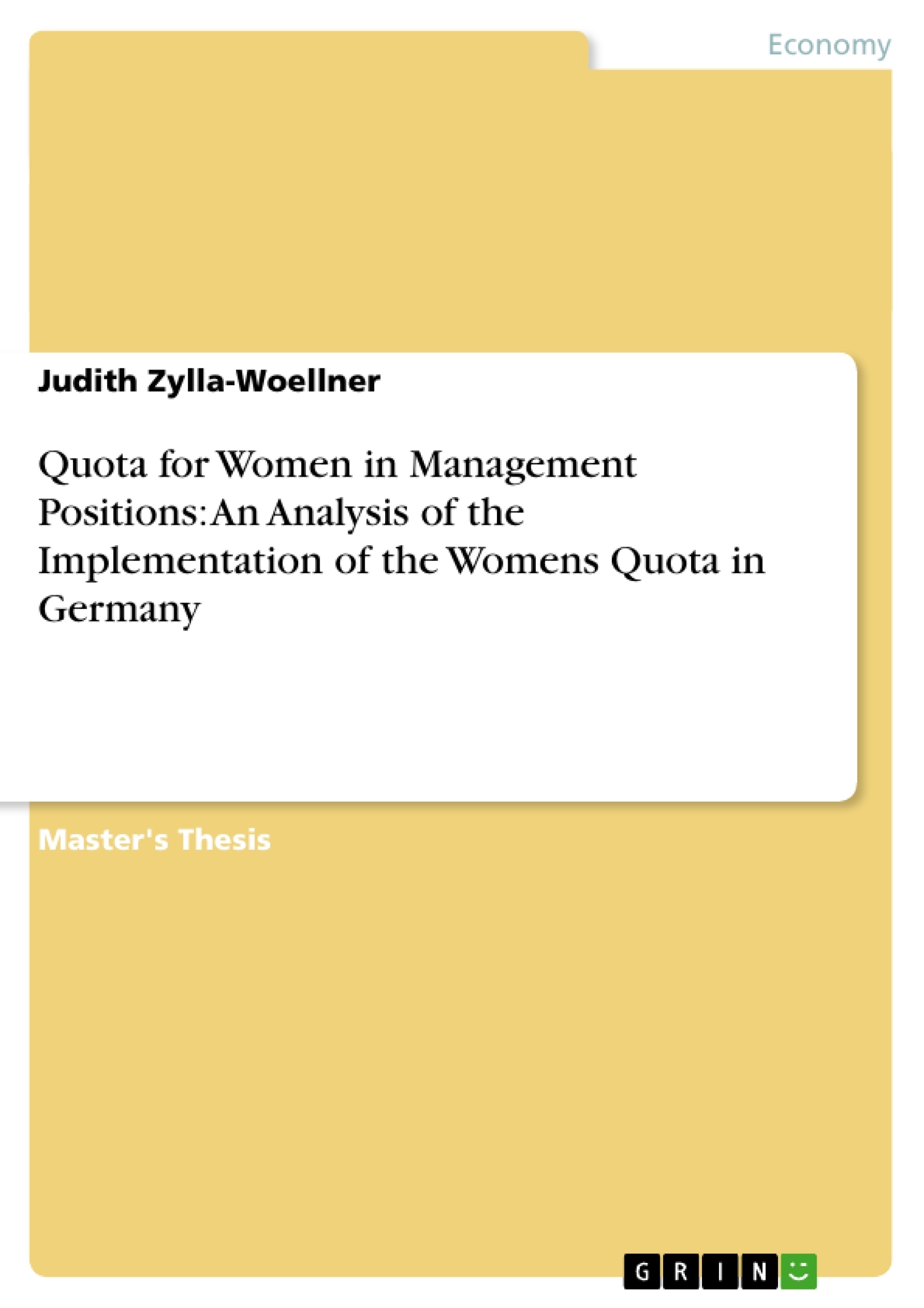In 1949 the German constitution set down the entitlement to equality for men and women in the Federal Republic of Germany in article 3.
Until the late 1950s it was up to men to decide where to live and how to utilise families’ assets.
Women were not permitted to decide about their participation in the labour market but had the duty to administer the household and help their husband.
When Angela Merkel became chancellor of Germany in 2005, she was not only one of the most influential politicians in the world but also one of the few female leaders who managed to break through the glass ceiling.
Chancellor Merkel herself blocked Minister of Employment, Ursula von der Leyens attempt towards affirmative action.
The fact of the matter is that Germany is lagging behind when it comes to women in leading positions.
In 2010, only 0,9% of the leadership positions in the 100 largest German companies and 2,6% in the top 200 companies are held by women.
(Holst & Wiemer, 2010) This is in stark contrast with the fact that at team-‐leader level in German companies, women represent 20% of staff after being almost 60% of university graduates.
This underrepresentation is especially difficult to understand since recent studies have shown a positive correlation between the proportion of women in management positions and companies’ performance, which made approximately 10% more in terms of profits with a balanced gender policy (Wiemer, 2010).
As a consequence, Germany is facing a discussion on the introduction of a women’s quota for management positions in German companies.
Currently there is a great debate on-‐going concerning the pros and cons of a women’s quota.
Inhaltsverzeichnis (Table of Contents)
- 1. INTRODUCTION
- 1.2. BACKGROUND & CAUSE FOR INTEREST
- 1.3. RELEVANCE FOR GERMANY
- 2. RESEARCH AIM & OBJECTIVES
- 2.1. METHODOLOGICAL APPROACH
- 2.2. RESEARCH DESIGN
- 2.3. LITERATURE REVIEW
- 3. THEORETICAL FRAMEWORK
- 3.1. TRANSACTIONAL VERSUS TRANSFORMATIONAL LEADERSHIP
- 3.2. CRITICAL ASPECTS
- 3.3. ARE THERE COMMONALITIES OF FEMALE AND TRANSFORMATIONAL LEADERSHIP STYLES?
- 3.4. IS THERE A TYPICAL FEMALE LEADERSHIP STYLE?
- 3.5. BETTER LEADERSHIP THROUGH WOMEN?
- 4. STATUS QUO IN GERMANY & DIFFICULTIES WOMEN ARE FACING
- 5. LEGAL AID CALLED WOMEN'S QUOTA
- 5.1. WOMEN QUOTA-ONLY FIGHTING THE SYMPTOM?
- 5.2. PROS & CONS OF WOMEN'S QUOTA
- 5.3. ACCOMPANYING MEASURE FOR MORE WOMEN IN MANAGERIAL POSITIONS
- 5.4. THE RIGHT WAY FOR GERMANY
- 6. CRITICAL APPROACH
- 6.1. FUTURE OUTLOOK & ADVANTAGES FOR COMPANIES
- 6.2. SUMMARY
Zielsetzung und Themenschwerpunkte (Objectives and Key Themes)
This dissertation aims to analyze the implementation of the women's quota in Germany and its potential impact on the representation of women in management positions. The paper explores the current status quo, challenges, and perspectives of women in leadership roles. It further investigates the theoretical framework of female leadership styles, particularly in relation to transformational leadership, and examines the arguments for and against the implementation of a women's quota.- Representation of Women in Management
- Gender Equality and Legal Frameworks
- Leadership Styles and Gender
- Pros and Cons of Women's Quotas
- Future Outlook and Potential Benefits of Increased Female Representation in Management
Zusammenfassung der Kapitel (Chapter Summaries)
- Introduction: This chapter introduces the topic of the women's quota in Germany and its historical context. It outlines the relevance of the issue for Germany, particularly in light of its current economic and demographic trends.
- Research Aim & Objectives: This chapter defines the research objectives of the dissertation, which includes analyzing the effectiveness of the women's quota and its impact on the representation of women in management positions. The methodological approach and research design are also outlined.
- Theoretical Framework: This chapter examines the theoretical frameworks of transactional versus transformational leadership, exploring the potential connections between female leadership styles and transformational leadership principles. It also investigates the existence of a typical female leadership style.
- Status Quo in Germany & Difficulties Women are Facing: This chapter presents the current state of women's representation in management positions in Germany, highlighting the challenges and barriers women face in their pursuit of leadership roles.
- Legal Aid Called Women's Quota: This chapter delves into the implementation of the women's quota, discussing its potential benefits and drawbacks. It examines the argument that the quota may be an insufficient response to the deeper societal challenges contributing to gender inequality.
- Critical Approach: This chapter provides a critical analysis of the women's quota, considering its potential impact on companies and the future outlook for women in management positions. It also summarizes the key findings of the dissertation.
Schlüsselwörter (Keywords)
This dissertation focuses on the implementation and impact of the women's quota in Germany. It investigates the current status of women's representation in management positions, exploring the challenges they face and the theoretical frameworks of leadership styles in relation to gender. Key themes include gender equality, leadership, diversity, and affirmative action. The dissertation examines the potential benefits and drawbacks of the women's quota, drawing on relevant research and case studies.- Quote paper
- Judith Zylla-Woellner (Author), 2012, Quota for Women in Management Positions: An Analysis of the Implementation of the Womens Quota in Germany, Munich, GRIN Verlag, https://www.grin.com/document/207985



